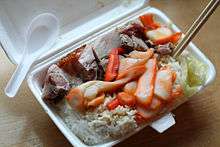Foam food container

A foam food container is a disposable container for various foods, including beverages. Food types may be processed (instant noodles), raw (meat from supermarkets), or cooked (delicatessen).
The containers are commonly used to serve takeout food from restaurants, and are also available by request for diners who wish to take the remainder of their meal home.
Construction
Foam take-out containers are made from EPS foam, or another type of polystyrene foam, and produced by injecting the foam into a mold. They are usually white in color, although they may be printed or impressed with a company logo or other message.
Styrofoam is a trademark of The Dow Chemical Company for closed-cell extruded polystyrene foam currently made for thermal insulation and craft applications. The term is often incorrectly used as a generic term for expanded (not extruded) polystyrene foam, such as disposable coffee cups, coolers, or cushioning material in packaging, which are typically white and are made of expanded polystyrene beads.
This is a different material from the extruded polystyrene used for Styrofoam insulation. The polystyrene foam used for craft applications, which can be identified by its roughness and by the fact that it "crunches" when cut, is moderately soluble in many organic solvents, cyanoacrylate, and the propellants and solvents of spray paint, and is not specifically identified as expanded or extruded. Another tradename for expanded polystyrene is thermacol, originated by BASF.
Varieties
Foam takeout containers come in different varieties. These may include:
- A rectangular shaped clamshell style container with an attached lid, which comes in various sizes. The larger ones usually feature several compartments, allowing different foods to be kept separated from each other. This variety usually features several small projections on the lid of the container, which fit through slots on the bottom half to "lock" it, therefore keeping the cover closed. These containers are leak-resistant only if kept upright, and often have a square imprint area for labeling.
- A cylindrical style container with a separate, translucent or opaque plastic lid which can seal tightly to resist leaks. The container may or may not taper somewhat towards the bottom. Both overall size, and the ratio of height to diameter can vary greatly. Such containers usually hold soups and stews; however, smaller varieties are often used to hold sauces and condiments.
Chinese cuisine
This is the most commonly used takeout box for Chinese cuisines in East and Southeast Asia. It is standard for Cantonese cuisine in Hong Kong and many parts of China. It is sometimes used overseas in various restaurants, particularly in the United States and Canada.
Issues
Environmental issues
Because foam takeout containers are entirely made out of polystyrene foam, these containers affect the environment as they do not biodegrade easily.[1] However, Methanogenic consortia degrade styrene, using it as a carbon source.[2] Pseudomonas putida can also convert styrene oil into various biodegradable polyhydroxyalkanoates.[3][4] Some cities have gone as far as banning the use of foam take-out containers, notably San Francisco,[5] Seattle[6] and Portland, Oregon.[7] In 2013, the mayor of New York City proposed banning foam food containers, for both health and environmental reasons.[8] This plan began to be implemented in early 2015, however a September court ruling has since put the ban on hold.
Health issues
It is debated whether styrene may migrate into food which is stored in foam food containers for even a small amount of time. Some researchers argue that polystyrene containers do pose a health risk,[9] while industry defenders argue that trace amounts of styrene are already naturally present in food.[10][11] Styrene foam containers can melt if the food or liquid is of a sufficient temperature. Some containers have been tested and labelled for safe use in microwave ovens; although the absence of such labeling does not mean a container is unsafe for this use, caution should still be taken.[12]
Styrene is considered by both the EPA and IARC to be a possible carcinogen. It poses a health risk to workers during production of styrene and polystyrene items, with industries using a compliance program to deal with liabilities.[13] Prolonged exposure to high amounts of styrene may affect the central nervous system, causing diseases like Parkinson's disease and multiple sclerosis.[14]
See also
References
- ↑ "Polystyrene Foam Report". Earth Resource Foundation. Earth Resource Foundation. Retrieved 20 March 2013.
- ↑ http://www.ceaa-acee.gc.ca/050/documents/56647/56647E.pdf
- ↑ Immortal Polystyrene Foam Meets its Enemy | LiveScience
- ↑ Ward, PG; Goff, M; Donner, M; Kaminsky, W; O'Connor, KE (2006). "A two step chemo-biotechnological conversion of polystyrene to a biodegradable thermoplastic". Environmental Science and Technology. 40 (7): 2433–7. doi:10.1021/es0517668. PMID 16649270.
- ↑ San Francisco Bans Styrofoam for To-Go Containers
- ↑ Seattle Styrofoam Ban Leads to Packaging Changes
- ↑ City of Portland Garbage and Recycling Rules and Regulations
- ↑ Grynbaum, Michael M. (February 13, 2013). "To Go: Plastic-Foam Containers, if the Mayor Gets His Way". New York Times. Retrieved 20 March 2013.
- ↑ Grimm, Grace. "Plastics Not to Reuse". Green Living. National Geographic Society. Retrieved 20 March 2013.
- ↑ Styrene Occurrence in Food
- ↑ Answers to Common Questions About Styrene
- ↑ "Microwaving food in plastic: Dangerous or not?"
- ↑ "Polystyrene Foam Report". Earth Resource Foundation. Retrieved 18 August 2015.
- ↑ Kolstad, Juel, Olsen, Lynge (May 1995). "Exposure to styrene and chronic health effects: mortality and incidence of solid cancers in the Danish reinforced plastics industry" (PDF). Occupational and Environmental Medicine. 52: 1. doi:10.1136/oem.52.5.320. PMC 1128224
 . PMID 7795754. Retrieved 18 August 2015.
. PMID 7795754. Retrieved 18 August 2015.